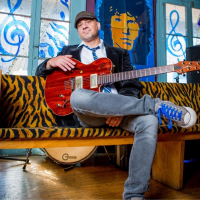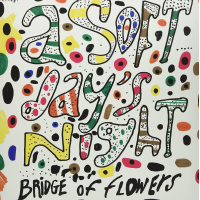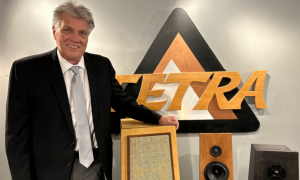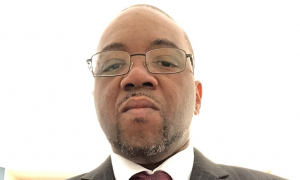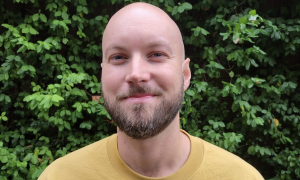Home » Jazz Articles » Chats with Cats » The Digital Content Producer: Joseph Vella
The Digital Content Producer: Joseph Vella
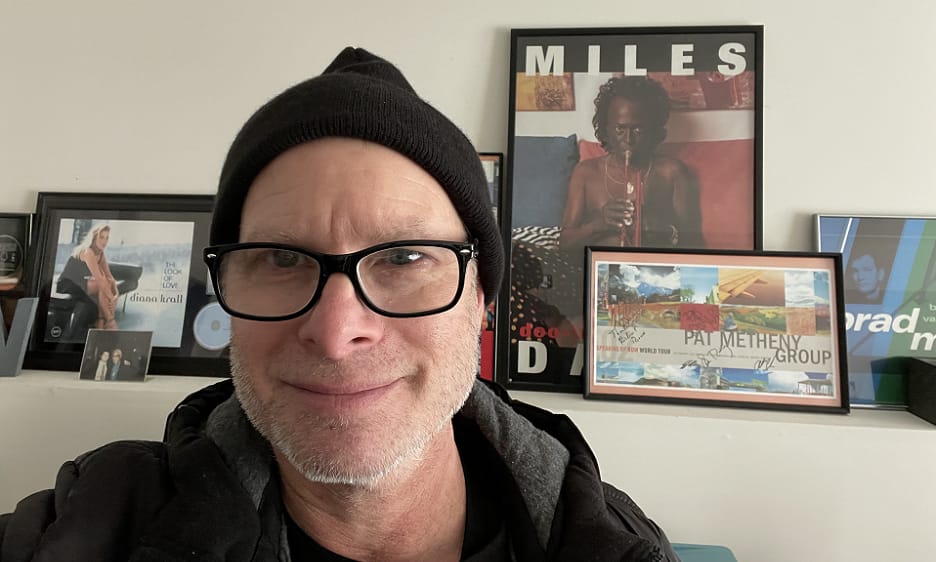
When I work with musicians, I emphasize quality over quantity... don't post just for the sake of posting something to 'stay relevant.' Post less frequently but make those posts meaningful, interesting and engaging.
—Joseph Vella
Joseph Vella has been on that technological edge since the beginning of the internet and has been able to combine his fascination with technology with his love of music, jazz in particular. He gave many of the marquee jazz institutions (record labels and musicians) their first online presence. I asked him how this all happened, how we can best use it, and where it's all going.
About Joseph Vella
Joseph Vella has spent the past three decades as a forward-thinking force in the digital music space specializing in issues of content development, marketing strategies, audio and video production, podcasting, and branding on social media. He ventured into the digital world in 1991 with the creation of Jazz Online, one of the internet's earliest music websites and the first to target the jazz audience. With this groundbreaking enterprise, Vella formed his company, Vella Interactive, and he subsequently advises a wide range of record companies and high-profile musical artists to develop their earliest online properties, content and marketing strategies. Today, he continues to evolve his practice producing a variety of websites, online radio programming and video content, social branding campaigns and podcast series, including spotlighting artists such as The The Beach Boys (Pet Sounds), John Coltrane (The Traneumentary), Pat Metheny (About The Music), Motown 50, Stephen Sondheim (The Story So Far) Yo-Yo Ma (An Intimate Tour Through the Music) and the Miles Davis Podcast. Vella also teaches master classes at NYU focused on digital content production and marketing.All About Jazz: Your background is a very technical one and your success seems to follow the rise of the internet. How did you become interested in technology early on?
Joseph Vella: Growing up in the Bay Area, technology was all around. Even in the seventies and eighties. We had a lot of that mass-oriented technology launch before other parts of the country. There was a progressive acceptance and opportunity with technology that I witnessed in the Bay Area. This was not because of the political left-leaning side of it but more in the leaning towards innovation, knowledge and science. That is a huge factor when you are a young and an impressionable kid who's very curious. You understand that amazing people can invent all sorts of very cool things that elevate our lives in a better way and for better living as a whole. I learned early on that the sky is the limit if we apply ourselves and expand our vision.
AAJ: You also have a love for jazz. How were you exposed to it? Were, or are, you a musician?
JV: My father was a local musician and played KJAZ radio in our house when I was growing up. He also had a record collection and played a variety of LPs including Dave Brubeck, Herb Alpert & The Tijuana Brass, Buddy Rich, and Sergio Mendes & Brasil '66. They were on heavy rotation, among others. I learned how to play music on my father's drum set at a very early age. I knew early on that I wanted to play jazz and that is what I did.
In high school, I was lucky and met a trio of brothers named Grenadier—Phil Grenadier, Steve & Larry Grenadier—along with pianist, Thom Daniels, and a saxophonist, Jon Shapiro. We all met and played in the jazz band but ventured out as a combo. We became close friends and avid record collectors and listeners. That is all we did in our teens outside of practicing. We frequently visited the famed San Francisco jazz club the Keystone Korner many times seeing legends Woody Shaw, Art Blakey, Tal Farlow, Red Norvo, Ahmad Jamal, Curtis Fuller, Stan Getz and many others. We learned very early that jazz needs to be experienced live to be fully appreciated.
We studied jazz from bebop to mainstream and beyond. This was during the fusion era so there was an incredible diversity in the music because of electronics and synthesizers and a creative merging of popular music of the day into jazz and so on. If I had to pick a theme song for us during those years it would be Freddie Hubbard's "Red Clay." We loved that tune.
Our combo competed in state competitions and eventually we won the California State Jazz Competition that was affiliated with the Monterey Jazz Festival under original founder Jimmy Lyons. We played the Monterey Jazz Festival in 1981. What a thrilling experience! One of the greatest memories I have of that entire experience was how hard we worked to get there, but also how much we loved jazz and the musicians who played it. In fact, we even invited our guitarist's teacher, the great Bruce Forman, to play with us on the last tune as an encore. It was surreal and the crowd loved it.
AAJ: Tell me about the music you love the most.
JV: I love all kinds of music and I always have looked at it as a lifestyle accompaniment or companion. I would say that jazz is where a lot of my interest lies. There is so much superb music to explore in jazz that it is endless. Jazz is always evolving so there is this ongoing innovation and integration constantly happening from everywhere which expands the music and, in many cases, the language. Jazz is not one type of music, which makes it so evocative.
As far as music I love the most, here are a few that come to mind. Hearing the Pat Metheny Group (late '70s) changed my life. I remember hearing "Phase Dance" and "San Lorenzo" on the radio and loved it from the first note. It spoke to me. In fact, my friends and I would see the PMG each summer at the UC Berkeley Greek Theater. I can't stress enough the impact of attending those live shows because the music was not purely jazz or rock but its own thing. Pat Metheny is an amazing guitarist. Lyle Mays was unbelievable behind his synths but also his piano playing was brilliant and matched Pat's guitar. You had these two guys with a balanced virtuosic presence showcasing music that was entirely new and fresh and unique to them. Together, they composed music that influenced the music itself and other players, back then to now. Magic was happening at those shows. They were like a rock band in presentation, but their music made the shared experience something you would not forget because the jazz spirit was at the core.
But also, the crowd at the PMG shows was all ages. People from all walks of life attended. It was unlike any jazz audience I ever saw and it influenced me as far as how I would approach my career in music. I saw jazz as a popular music that could attract people my own age and my parents' age and listeners in between. And it was good business.
I was blown away by an album by the Paul Winter Consort entitled Icarus (Epic, 1972) that features the original members of Oregon with special guests David Darling, Billy Cobham and bassist Herb Bushler. It's a masterpiece and quite profound in the music presented, albeit somewhat dated now. It opened my ears up in a new and different way to listen, which was exciting.
Lastly, I have a fondness for two trios. The first is the Oscar Peterson Trio featuring Ray Brown and Ed Thigpen, and the Standards Trio with Keith Jarrett, Gary Peacock, and Jack DeJohnette. To me, both of those groups represent the two main sides of jazz that I love in small group settings. If I had to equate a painting style to both, Peterson's trio would be more like a still life. They are lovely and swinging, so precise and hard. They were tight in their arrangements and what can you say about their repertoire? It's solid and even today, sounds fantastic in every way
The Jarrett Trio is playing a similar repertoire but is the opposite in that it is more impressionistic. They take longer to tell the story and to get to the swing which they do so well. It is a bit more loose and extended [with] open solos. The dynamics are incredible and it makes for a different listening experience but yields the same and complete satisfaction in the end.
AAJ: You were a pioneer in setting up an online presence for some of the biggest entities in music. How did that come about?
JV: In the early 1990s, I was introduced to a radio airplay reporting bulletin board and the Prodigy network. I had decided to not play music as a career but wanted to shift my focus to marketing jazz to young people like myself because no one was doing it. It was a logical process to use the bulletin board medium to create my own entity and present all kinds of jazz release and historical information. The only problem was that I was not a computer programmer nor had much experience in that realm. So, I ended up taking the plunge and buying a 386 computer, a scanner and bulletin board software and began teaching myself how to operate the computer—pre-Windows—and figure out how to program the software, etc. It was difficult but eventually I figured it out and built the first Jazz Online bulletin board system.
In order to get people to sign up for it for it, I made a deal with KJAZ radio and traded content space on the bulletin board to promote their programming in return for an on-air commercial to get the word out on my network. It was a great relationship and I quickly attracted over 2,000 jazz fans from all around the Bay Area. My first client was Warner Bros. Jazz and the first recording promoted on Jazz Online was Miles' Doo-Bop. That would be 1992.
Once the system was working, I went to New York and gave demonstrations of the bulletin board system to all of the big labels so I could get on their press list. I met everyone there and many of the label reps became supportive allies, friends and clients. They were instrumental when I launched the Jazz Online website in 1993. As the web hit, all of the record labels and many artists wanted to get online but not many people knew the technology and the internet, how to navigate the terrain, build websites or do promotions. That is when I started my consulting business and worked with a variety of labels and artists. The work exceeded the jazz space and extended into classical, world and pop. It was an exhilarating period.
In some ways, the rise of the web was similar to the evolution of jazz that I studied and was a part of as a musician in that there was a basic language and history and then styles evolved from the base and everything was always in a state of change. I felt right at home working in the online space inside of the music business arena.
After all of these decades later, it is still similar even though the technology and terms have evolved. Sadly, the music business aspect of all of this has eroded.
AAJ: Because you were involved so early on, has it been difficult for you to stay on top of the digital world that has changed so dramatically since that time?
JV: It was very clear that the digital space is always transitioning into something new and different. The trick to survival is understanding what the base staples are because those really don't change. The foundation of the internet/web have always been the same. The names of applications or tools and trends have changed. The speed of access has changed. I try and stay on top of it by going online and trying all things out. I read a lot about technology and study what users are doing online. It is fascinating in that nearly the entire world is connected now and communicating with one another in live time. It has made our universe much more like a community, which is great, but at the same time it has taken a little of the mystery out of things, which is not necessarily a good thing.
Having a 21-year-old daughter keeps me somewhat relevant on much of the social frontier. My wife is a digital professional and an active user, so we talk a lot about all sorts of stuff related to the digital world. I also have many friends and colleagues who are in different working areas, and we do a good amount of talking, and sharing of content and other related activities.
AAJ: Tell me about the podcasts that you produce.
JV: In 2000, I started producing podcasts but they were not called podcasts then. There were sort of like short radio shows except more creative. My aim was to produce a unique glimpse into the artist, their music, their story and also offer an intimate experience for the listener.
My interest was, and still is, to work with artists in a unique way to share their music or process. Or simply to celebrate another's music like I did producing The Traneumentary. That series was designed to introduce Coltrane's music to the expanding—and younger—digital audience. It was extremely effective at that.
When I produced Pat Metheny's podcast or my work with Yo-Yo Ma or when I produced a series on Sondheim, I develop questions and narratives around both the musical content and personalities featured so, it allows the listener to feel and hear the artist and their work speaking directly to them in a very intimate manner. I am always striving to create a rich emotional connection with the audience.
I have been very lucky and have worked with a wide variety of legendary artists so I have been able to hone in on my style and skills through producing thousands of podcast episodes. Over the years I've produced assets and worked closely with Lyle Mays, Charlie Haden, Brian Wilson, Elvis Costello, Herbie Hancock, Brad Mehldau, Joshua Redman, LL Cool J, Queen Latifah, Billy Bob Thornton, Chris Blackwell , Wayne Shorter, Jose Gonzalez, NYU and many others. In addition, I have produced long-form series on musical topics such as The Miles Davis Podcast, Motown 50, and Masterworks Broadway Podcast Theater, to name a few.
I've evolved into producing more conversational podcast series which is more in line with today's approach.
AAJ: What kind of advice would you give to musicians who are navigating this world on their own and are trying to develop an online presence?
JV: For the most part, active artists or bands need to have their own website and social presence updated regularly. Also, their music needs to be on YouTube and in all of the streaming services and tour info easily accessed. The use of social media is crucial, but I emphasize [that] the tone of content be carefully thought out. Posting frequency and content quality is vital. Postings should offer something of interest to followers that maintain the brand. The fact that musicians can interact and engage with their consumers is a very effective and productive aspect of the scene in 2022, but there is a fine line to turning them off too.
When I work with musicians, I emphasize quality over quantity: don't post just for the sake of posting something to "stay relevant." Post less frequently but make those posts meaningful, interesting and engaging. Too many musicians are flooding social media with irrelevant posts and it just causes a lot of noise and digital clutter which is probably not the goal. You can really turn an audience off with shameless promotional content. That said, I recommend that musicians utilize all of the social channels in a unique manner and create specific content for each channel that they use. Be authentic and original and enjoy it!
For example, last year I created/produced a TikTok series with sax great Tom Scott encouraged by my daughter during the pandemic. But instead of focusing on his five-decade jazz career, I decided to point the TikTok content to Tom's work as a first-call studio musician playing on legendary pop tunes. It was an aspect of Tom's career that was unique to him, and the series has been effective for Tom and a perfect use of TikTok. It has also been a lot of fun to produce, and he and I continue to evolve the content. We also answer questions from the audience and receive suggestions for future TikToks.
AAJ: Do you have any hobbies outside of the tech and music worlds?
JV: I love watching movies and compelling series. I guess it's one of the more positive aspects of pandemic life that we are all experiencing. There is no shortage of great content to watch.
AAJ: Where is this technology going? What's next for the musical world?
JV: That is a great question for which I don't have a definitive answer for you. I tend to think we will see more evolution in streaming but I hope that artists can earn more money per stream so it makes a difference to them and their careers. I am concerned that making a living in jazz in particular is becoming harder and harder.
Perhaps we will see more advanced usage of video streaming in clubs and concerts halls that will become income streams for the venue and artists, better quality visually and sonically away from Facebook Live or Zoom, but maybe a new platform that is seamless on all devices. Perhaps the audio portion can be offered digitally afterwards as part of the ticket price on special occasions. Artists can then integrate the product with their websites and social media posts. That way I can visit Ronnie Scott's or The Blue Note or Yoshi's or the Monterey Jazz Festival no matter where I live and celebrate my favorite artists/bands. Other merchandise can be sold as well. Perhaps we will see more of a profitable service-oriented profession modeled by musicians as their own entities in the future.
For jazz, I believe the technology needs to help/continue expand the audience in a much larger way than we are seeing now. In addition, jazz artists need to realize that their music must connect to an audience of a greater size and they in turn become performers that engage their audiences. Being a performer does not degrade the art of the music; it is simply vital for business. It is very much what I witnessed seeing the Pat Metheny Group at an early age. We need more of that right now than ever before.
Tags
Chats with Cats
B.D. Lenz
United States
California
san francisco
Beach Boys
John Coltrane
Miles Davis
pat metheny
Yo Yo Ma
Dave Brubeck
Herb Alpert & the Tijuana Brass
Buddy Rich
Sergio Mendes & Brasil '66
Sam Francisco
keystone korner
Woody Shaw
Art Blakey
Tal Farlow
Red Norvo
Ahmad Jamal
Curtis Fuller
Stan Getz
Monterey Jazz Festival
Jimmy Lyons
Bruce Forman
Pat Metheny Group
Lyle Mays
Paul Winter Consort
Oregon
David Darling
Billy Cobham
Herb Bushler
Oscar Peterson Trio
Ray Brown
Ed Thigpen
Keith Jarrett
Gary Peacock
Jack DeJohnette
New York
Charlie Haden
Brian Wilson
Elvis Costello
Herbie Hancock
brad mehldau
Joshua Redman
LL Cool J
Queen Latifah
Wayne Shorter
Jose Gonzalez
Tom Scott
Ronnie Scott's
The Blue Note
Yoshi's
PREVIOUS / NEXT
Support All About Jazz
 All About Jazz has been a pillar of jazz since 1995, championing it as an art form and, more importantly, supporting the musicians who make it. Our enduring commitment has made "AAJ" one of the most culturally important websites of its kind, read by hundreds of thousands of fans, musicians and industry figures every month.
All About Jazz has been a pillar of jazz since 1995, championing it as an art form and, more importantly, supporting the musicians who make it. Our enduring commitment has made "AAJ" one of the most culturally important websites of its kind, read by hundreds of thousands of fans, musicians and industry figures every month.

